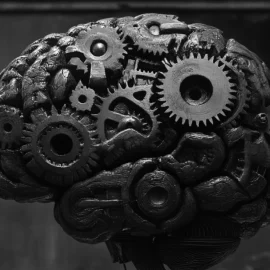

This article is an excerpt from the Shortform book guide to "The Man Who Mistook His Wife for a Hat" by Oliver Sacks. Shortform has the world's best summaries and analyses of books you should be reading.
Like this article? Sign up for a free trial here .
What is the difference between aphasia vs. agnosia? What are some examples of each?
In his book The Man Who Mistook His Wife for a Hat, Oliver Sacks examines multiple cases of aphasia and agnosia. He describes the behaviors of patients with each condition and explains the differences between the two.
Here are Oliver Sacks’ case studies and an explanation of the difference between aphasia vs. agnosia.
Reagan’s Speech and the Aphasiacs
Oliver Sacks’ case studies of aphasia vs. agnosia begin with a study of aphasiacs. Neurologists often speak of brain disorders in terms of deficits. A deficit is some impairment of neurological function, usually linked to brain damage to some particular area. Damage to Broca’s area, for example, is known to cause aphasia.
The ability to understand language is one of the defining traits of humanity. Other organisms communicate through sounds, but there is no parallel to the evocative power of human speech. Yet some people who’ve suffered brain damage are robbed of this ability. They suffer from aphasia—the inability to process and understand spoken words.
But, as we’ve seen, the brain has a remarkable ability to compensate for deficits in one area with neurological surpluses in another. Aphasiacs may possess an uncanny ability to look beyond the veil of words and derive true meaning more clearly than anyone.
Aphasia: Seeing Past the Words
In the 1980s, Sacks was at an aphasiac ward of a psychiatric hospital, where the patients were watching a televised speech being given by President Ronald Reagan. Their aphasia inhibited them from processing and understanding the words the president was speaking. But they could still understand the non-verbal aspects of language, indeed, far better than most other people. Sacks observed that they were highly attuned to the changing rhythms, intonations, and cadences of Reagan’s speech.
Looking past the words prepared by Reagan’s speechwriters, they heard only his tone and inflection. Based upon this, they saw the polished actor-turned-president as a dissembling phony, keenly picking up on the falseness of his tone and body language. And their reaction to his speech was not reverential respect—it was uproarious, hysterical laughter! Sacks learned that one cannot fool an aphasiac with slick rhetoric, because they have extra heightened sensitivity to tone and can never be misled with words.
Agnosia: Just the Words
Agnosia presents the exact opposite condition. Someone with agnosia can understand only words, but not tone or expression. Sacks asked an agnosia patient named Emily D. how she interpreted Reagan’s address. Because she could understand nothing but words, Emily needed people to use precise wording in order for her to derive meaning from speech. Slang, colloquialisms, metaphors, or any other imprecisions of language would render what she was hearing incomprehensible.
When she listened to Reagan’s speech, she focused on its imprecision with words. The president was not clear in what he meant, and, according to Emily, this meant he was either brain-damaged or being dishonest. Once again, it took patients with brain damage to look past Reagan’s slick speech and see it for what it really was.

———End of Preview———
Like what you just read? Read the rest of the world's best book summary and analysis of Oliver Sacks's "The Man Who Mistook His Wife for a Hat" at Shortform .
Here's what you'll find in our full The Man Who Mistook His Wife for a Hat summary :
- Neurologist Oliver Sacks' case studies on patients with neurological impairments
- The remarkable complexity of the human brain and its extraordinary capacity to adapt
- How Sacks' work with his patients shows the pitfalls of traditional thinking about neurological disorders






